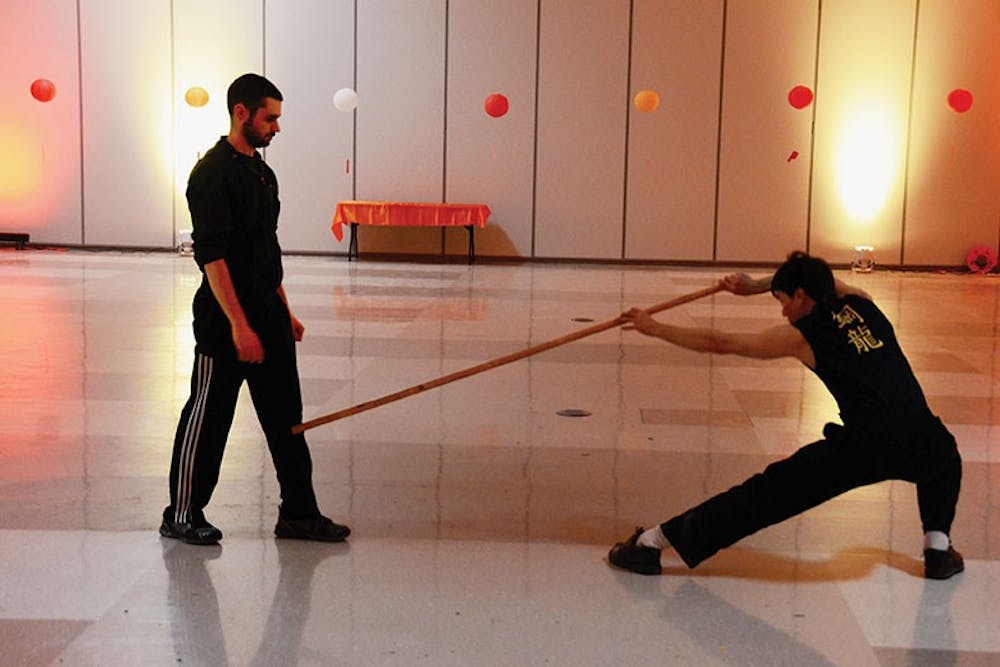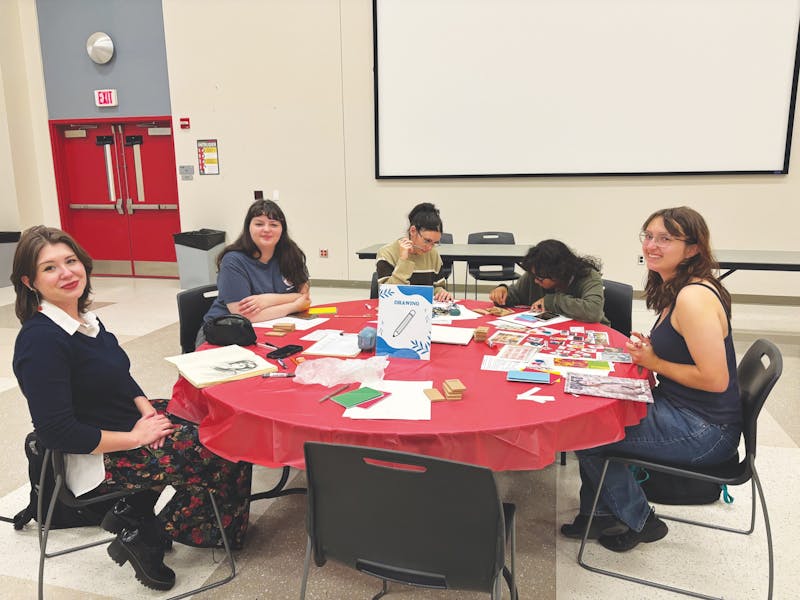Electric blue eyes bulged from the lion’s wide, red head as he curiously peered closer and closer into students’ faces. His mouth chomped open and close as he approached, nearly knocking over a girl as she backed away and he came even closer, shaking his ornate head so the black strings dangling from his chin danced. The lion’s permanent smile, so slight but stretching across from one side of his face to the other, made him look more like an eager puppy and less of a ferocious beast as he sniffed the students and wriggled his orange-red and gold striped body.
The Activities Program Board (APB) celebrated the Chinese New Year Thursday evening under tissue paper draped in sagging arcs across the ceiling, pink and glowing paper orbs dangling from string in the Ceddia Union Building (CUB). As a special guest for the Moon Lantern event, Street Dragon Martial Arts came from Pittsburgh, bringing with them a Chinese tradition, a lion dance.
“I definitely got a kick out of the lion coming out into the audience and getting so close,” said junior Kathleen Foley, the girl in the audience who almost tipped over as the lion butted his head in her face.
Two men from the martial arts team worked together to bring life and energy into the lion’s lank, cloth body and bulbous head. The dancers’ legs, peeking out from beneath the lion, instilled such grace and unison that they became the legs and paws of the lion itself pounding out a rhythm to the beat of a deep drum and clashing symbols.
This tradition originates with a 2,000 year-old tale, Chris Young said, instructor at Street Dragon Martial Arts. There are many stories surrounding the lion dance, but one tells that the Persians gave the Chinese emperor a lion as a gift. When the lion died, the Chinese wanted to preserve his magnificence and ferocity, Young said.
The actual lion dance emerged about 500 years later, but since no one knew exactly what a lion was supposed to look like, it became a hybrid of dragon, phoenix and dog, Young said. Two styles, southern and northern, evolved. The northern lion dance is typically performed by acrobatic groups, and the southern dance, which is what Young’s performers did, tells a story.
Each year they change their performance and base the story on the animal of the Chinese New Year, which is the ram this year, Young said. A red bench, propped on its side so that it stuck straight up, represented the ram and the bench legs the ram’s horns. Balanced on top of the bench was a head of lettuce. The lion finished his dance by grabbing the lettuce and thrashing his head and gnashing the lettuce into bits that he strew over the audience.
“If you got hit by lettuce it means you get one year of good luck,” Young said to the audience after the lion dance. The lion is believed to have descended from the heavens, and so by eating the lettuce and spitting it back out he gives that luck to whoever the lettuce touches.
The Chinese New Year revolves around good luck and prosperity. Arranged in the middle of the room on top of a table was a fake tree that is part of a Chinese tradition where people write a wish on a piece of paper and throw it has high as possible into the tree. The higher the wish, the more likely it will come true, Claudia Prieto, multicultural affairs chairperson, said.
Students gazed up at the tree and heaved their wishes into air and watched them tumble back to the floor. It took several good thrusts to get their wishes to stick in the tree’s branches, but eventually red slips of paper dotted the green foliage.
“I believe in luck,” Penny Kline said. “I’m a Penny,” she said referring to her name as she too, tossed her wish in the air.
Also available was an arts and crafts table where students could learn how to make a prosperity knot, which looks like a three-looped cross with three coins dangling from the string. It is supposed to bring prosperity and good fortune, Prieto said.
Prieto organized the moon lantern festival as a way to spread diversity, she said.
“In this campus we definitely lack openness and cultural awareness,” Prieto said.
Consistent with a Chinese New Year were riddles, written on slips of paper that teased students from dangling string. The riddles, as well as the tangerines that filled a huge bowl on one of the tables, would have been meant for the kids, Prieto said.
At the end of the event, after the lion dance, Young opened the floor for questions. Then he asked if anyone wanted to learn kung fu. Young and his apprentices demonstrated fiver different forms of kung fu, each one a graceful dance that could end in serious injury if executed accurately.



The Slate welcomes thoughtful discussion on all of our stories, but please keep comments civil and on-topic. Read our full guidelines here.